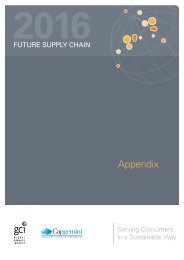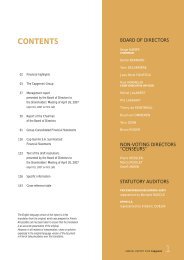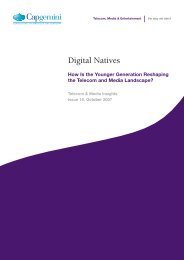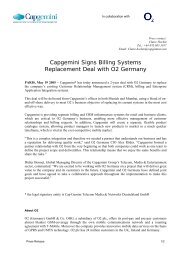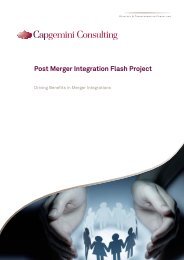Transportation Management Report 2011 - Capgemini
Transportation Management Report 2011 - Capgemini
Transportation Management Report 2011 - Capgemini
You also want an ePaper? Increase the reach of your titles
YUMPU automatically turns print PDFs into web optimized ePapers that Google loves.
3<br />
model and its ability to effectively<br />
reduce logistics costs and improve<br />
customer service in the current<br />
global economic climate.<br />
• Many companies are using home<br />
grown software to support their<br />
transport function, especially<br />
for areas like rating, operational<br />
planning, and operational<br />
accounting that are difficult to<br />
support using standard off-theshelf<br />
software. A lot of these<br />
legacy transport systems were first<br />
installed in the early eighties and<br />
have been extended since then.<br />
From a technological point of view,<br />
legacy systems are fast approaching<br />
the end of their lifecycle. In “The<br />
TMS Legacy Dilemma” Annemarie<br />
van Meesche goes into different<br />
strategies for making changes in<br />
these environments.<br />
• The constraints that apply when<br />
introducing a modern TMS<br />
solution have tightened. Now,<br />
in addition to an extremely<br />
complex and inflexible application<br />
landscape comes the added<br />
burden of investment budgets<br />
being cut significantly. Logistics<br />
specialists are therefore looking<br />
for a migration strategy that not<br />
only reduces the business and<br />
technology risks, but also takes<br />
into account the current constraints<br />
in respect to investment budget<br />
and cash flow/ROI. An incremental/<br />
phased approach seems like the<br />
obvious solution to dealing with<br />
these constraints. Today’s methods,<br />
tools, applications, and integration<br />
technology provide us with a new<br />
dimension of flexibility that is<br />
crucial for a phased transition. But<br />
often when a company chooses<br />
an “off-the-shelf” (i.e., packagebased)<br />
TMS solution, they lack<br />
the expertise and resources to<br />
ensure the necessary flexibility. In<br />
the article “Response to the Crisis:<br />
Phased Introduction of a TMS”, Jan<br />
Lindhaus and Olaf-Rüdiger Hasse<br />
illustrate how <strong>Capgemini</strong>’s Service<br />
Oriented Package-Based Solutions<br />
(SOPS) methodology can help you<br />
bridge this gap.<br />
<strong>Transportation</strong> <strong>Management</strong><br />
Systems<br />
Part II of the report provides an<br />
overview of the available applications<br />
that support <strong>Transportation</strong><br />
<strong>Management</strong>. Twenty eight vendors<br />
were surveyed and provided<br />
input to the inventory of products<br />
presented. <strong>Capgemini</strong> editors have<br />
added clarifications and views to<br />
the text accompanying the vendor<br />
information tables. Some highlights:<br />
•It is important to recognize that<br />
there are different groups of TMS<br />
users: carrier, logistics service<br />
provider, and shipper. Although<br />
they have some requirements<br />
in common, their differences<br />
are important when selecting a<br />
solution.<br />
•Advanced Planning & Scheduling,<br />
Route Optimization, Parcel<br />
Shipping, and Global Trade<br />
<strong>Management</strong> functionality are areas<br />
that can be part of a comprehensive<br />
TMS. These parts are also available<br />
as stand-alone solutions, while<br />
some vendors offer these thirdparty<br />
components as options to<br />
their own solution.





